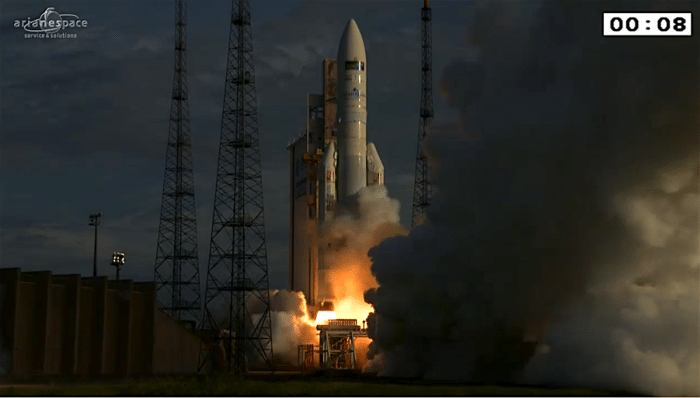Ariane 5 Ties Ariane 4 Record with Dual Launch for ISRO and NBN
[Via Satellite 10-06-2016] Arianespace completed the 74th consecutive successful mission of the Ariane 5 launch vehicle Oct. 5, tying the record of its predecessor, the Ariane 4, with a mission for customers in India and Australia. The dual launch delivered Australian national satellite operator NBN’s Sky Muster 2 into Geostationary Transfer Orbit (GTO) 28 minutes after liftoff, followed by GSAT 18 four minutes later for the Indian Space Research Organization (ISRO).
Sky Muster 2 is the second of two NBN satellites both built by Space Systems Loral (SSL) and launched by Arianespace, with the first, Sky Muster 1, orbited in 2015 on an Ariane 5. The satellite helps NBN bridge the digital divide in Australia by reaching rural and isolated regions of the continent, as well as the Norfolk, Christmas, Macquarie and Cocos Islands. It carries high throughput Ka-band transponders and will operate from an orbital position of 135 to 150 degrees east.
ISRO’s GSAT 18 is the 20th satellite Arianespace has launched for the Indian space agency. Equipped with 12 transponders in Ku-band and another 24 in C-band, the satellite is to provide telecommunications services for India once in its final orbital position at 74 degrees east, strengthening ISRO’s current fleet of 14 operational satellites.
This launch was also an opportunity for Airbus Safran Launchers (ASL), prime contractor for the Ariane 5 to conduct research for Europe’s next generation Ariane 6 launch vehicle. Following completion of the commercial mission, the company performed the third in a series of experiments to observe the movement of the residual propellants. ASL used several sensors and a camera installed in one of the upper stage tanks to gain a clearer understanding of fuel behavior during the long ballistic phases necessary for the new Ariane 6 missions. The European Space Agency (ESA), which financed this work, will join ASL in analyzing the findings.
The Ariane 6 launcher’s first flight is scheduled for 2020, following which there will be an overlap of Ariane 5 and Ariane 6 missions until the latter fuller replaces the former in about 2023.
